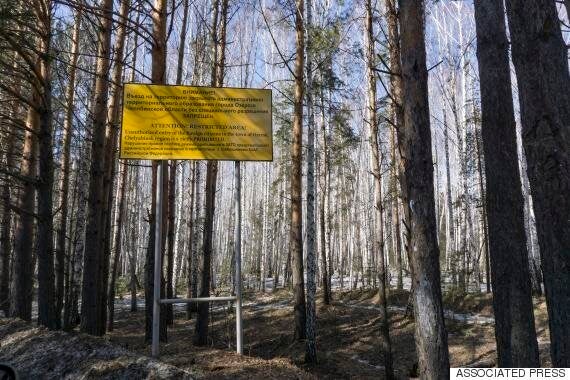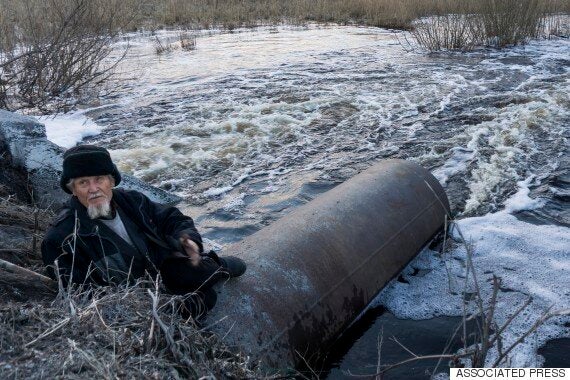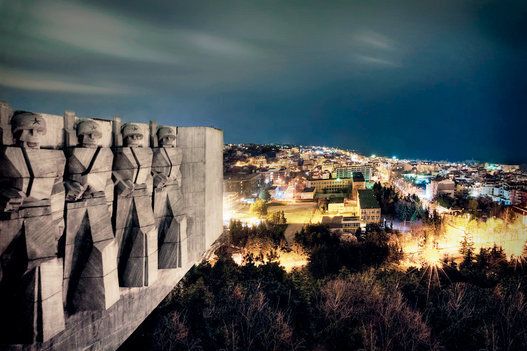
In this photo taken on Friday April 8, 2016, a sign warns people not to enter the town of Ozersk, Chelyabinsk region, Russia, which houses the Mayak nuclear facility. Mayak is a nuclear complex that has been responsible for at least two of the country's biggest radioactive accidents. (Photo: AP Photo/Katherine Jacobsen)
For years now, we have been warned by our governments, the international media and the terrorists themselves about the threat of a nuclear attack that would destroy our civilization as we know it. As an Iranian-born American, the fear of a nuclear attack by a rogue state or a terrorist is more than a story in the media for me.
So I decided to go to Russia, a country with approximately 8,000 nuclear warheads, which has a larger nuclear arsenal than the rest of the world combined. My plan was to discover how hard it would be for a non-state individual, a would-be terrorist, to gain access to enough nuclear material and technology to pose a real threat.
In Moscow, I learned about Russian nuclear closed cities, collectively known as Z.A.T.O., built after the Second World War to create the Soviet Union's nuclear-weapon program.
To keep their locations secret from the enemy, the closed cities were vanished from the maps for decades to come and their names were often changed.
After the collapse of the Soviet Union and the end of the Cold War, most of the secret cities were shut down. Among those still in existence is City 40.
Since its founding, the city has been surrounded with double barbed-wire fences and monitored by armed guards.
Today known as Ozersk, City 40 is considered the founding place of the Soviet Union's nuclear weapons program, where the first Soviet plutonium-based bomb, known as "First Lightning," was made.
Built in 1947 around the Mayak nuclear factory, City 40 has a population of approximately 100,000 today. It is located in the industrial region of Chelyabinsk in southern Urals. In the past, the city was also known as Chelyabinsk 40 and Chelyabinsk 65. The digits are the last digits of the postal code, and the name is that of the nearest city of Chelyabinsk.
Since its founding, the city has been surrounded with double barbed-wire fences and monitored by armed guards.
From 1947 to 1954 the residents were forbidden to leave or have contact with the outside, including with their family and friends. Since 1954 to present day their movements to and from the city are tightly controlled. Foreigners and non-resident Russians are prohibited from entering the city without special permission. And under Russian law, filming in the area is strictly forbidden. With the help of several locals, the crew and several cameras were smuggled inside the forbidden city.

In this photo taken on Thursday, April 7, 2016, an old man fishes in a lake that connects to the nearby Techa River, near the village of Muslyumovo, Chelyabinsk region, Russia, which is polluted with radioactive waste from Mayak nuclear plant. (Photo: AP Photo/Katherine Jacobsen)
We learned that a majority of the residents live near and work for Mayak. We were told that the Mayak Nuclear Complex is where almost all of fissile material in Russia is stored today. Meanwhile, the factory continues to produce components for nuclear weapons and the Russian military.
Meanwhile for over half a century, Mayak has been dumping nuclear waste into the environment. Initially, it was discharging high-level radioactive waste into a nearby river, which was taking waste to the River Ob, flowing northward to the Arctic Ocean. But soon, Mayak's dumping of nuclear waste expanded to other lakes and rivers in the region. As a result, Ozersk and its surrounding areas have become some of the most contaminated places in the world, and referred to by many as the "graveyards" of the earth.
Inside, we found a city similar to a prison house, and its residents living in exile. We learnt about personal tragedies, lethal landscapes and massive environmental catastrophes its citizens were born to bear.
Despite grave personal risks, several brave citizens decided to break their silence and talk about their invisible city. They told us about their parents and grandparents who were relocated there by the order of the Soviet Party to build the atomic bomb. They were told that they were the "nuclear shield" and "saviors of the world," and that everyone on the outside was an enemy. This ideology is what keeps them running to this day.
Behind the barbed wire fences, we witnessed paradoxes between the natural and the extraordinary; the everyday and the tragic; the individual and the universal; life and death. Workers who did not want to starve to death earning poisoned bread knowing that it would kill them.
A several polar contrasts formed among the serenity of the area's beautiful nature. The perfume of flowers and the heavy smell of death. Water and soil, symbols for life, heavily contaminated, now cause death. The air was fresh, but full of disease. Mother Nature turned into a massive graveyard -- an ominous comment on the government's indifference turning its back to nature, truth and action. As a result people's activities were their answers for ways of living under the sentence of death.
We realized that beside lives, there were values that were being annihilated, and that townspeople were divided into two groups 1) those who had succumbed 2) those who were running after hope. At the same time, everyone seemed to be doubly imprisoned: within City 40 and within themselves; and this double-barred atmosphere of each man was new and menacing for us looking in from the outside.
What had started as an investigation into the possibility of a nuclear threat by a non-state individual or terrorist group evolved into a film about the tragic human and environmental cost of the nuclear power.
It also became a political narrative about the formation of the personal and collective identity of a group within manufactured spaces living in fear and ruled by a totalitarian regime.
In the final analysis, City 40 is a microcosm of Russia today and an environmental catastrophe in the making.
CITY 40 had its world premiere at the Hot Docs Canadian International Documentary Film Festival in Toronto.
Follow HuffPost Canada Blogs on Facebook
MORE ON HUFFPOST:
